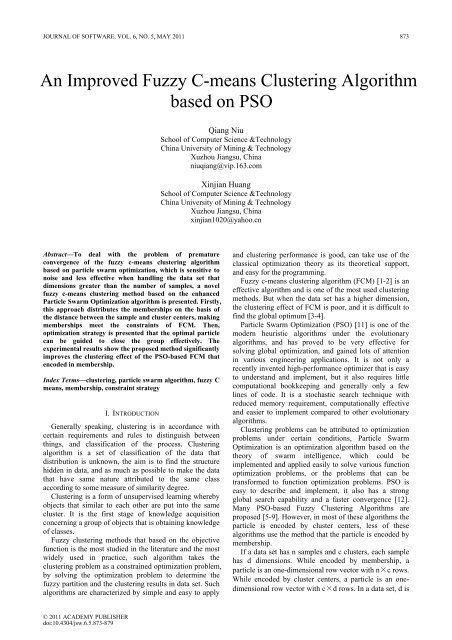Journal of Software - Academy Publisher
Journal of Software - Academy Publisher
Journal of Software - Academy Publisher
Create successful ePaper yourself
Turn your PDF publications into a flip-book with our unique Google optimized e-Paper software.
JOURNAL OF SOFTWARE, VOL. 6, NO. 5, MAY 2011 873<br />
An Improved Fuzzy C-means Clustering Algorithm<br />
based on PSO<br />
Abstract—To deal with the problem <strong>of</strong> premature<br />
convergence <strong>of</strong> the fuzzy c-means clustering algorithm<br />
based on particle swarm optimization, which is sensitive to<br />
noise and less effective when handling the data set that<br />
dimensions greater than the number <strong>of</strong> samples, a novel<br />
fuzzy c-means clustering method based on the enhanced<br />
Particle Swarm Optimization algorithm is presented. Firstly,<br />
this approach distributes the memberships on the basis <strong>of</strong><br />
the distance between the sample and cluster centers, making<br />
memberships meet the constraints <strong>of</strong> FCM. Then,<br />
optimization strategy is presented that the optimal particle<br />
can be guided to close the group effectively. The<br />
experimental results show the proposed method significantly<br />
improves the clustering effect <strong>of</strong> the PSO-based FCM that<br />
encoded in membership.<br />
Index Terms—clustering, particle swarm algorithm, fuzzy C<br />
means, membership, constraint strategy<br />
I. INTRODUCTION<br />
Generally speaking, clustering is in accordance with<br />
certain requirements and rules to distinguish between<br />
things, and classification <strong>of</strong> the process. Clustering<br />
algorithm is a set <strong>of</strong> classification <strong>of</strong> the data that<br />
distribution is unknown, the aim is to find the structure<br />
hidden in data, and as much as possible to make the data<br />
that have same nature attributed to the same class<br />
according to some measure <strong>of</strong> similarity degree.<br />
Clustering is a form <strong>of</strong> unsupervised learning whereby<br />
objects that similar to each other are put into the same<br />
cluster. It is the first stage <strong>of</strong> knowledge acquisition<br />
concerning a group <strong>of</strong> objects that is obtaining knowledge<br />
<strong>of</strong> classes.<br />
Fuzzy clustering methods that based on the objective<br />
function is the most studied in the literature and the most<br />
widely used in practice, such algorithm takes the<br />
clustering problem as a constrained optimization problem,<br />
by solving the optimization problem to determine the<br />
fuzzy partition and the clustering results in data set. Such<br />
algorithms are characterized by simple and easy to apply<br />
© 2011 ACADEMY PUBLISHER<br />
doi:10.4304/jsw.6.5.873-879<br />
Qiang Niu<br />
School <strong>of</strong> Computer Science &Technology<br />
China University <strong>of</strong> Mining & Technology<br />
Xuzhou Jiangsu, China<br />
niuqiang@vip.163.com<br />
Xinjian Huang<br />
School <strong>of</strong> Computer Science &Technology<br />
China University <strong>of</strong> Mining & Technology<br />
Xuzhou Jiangsu, China<br />
xinjian1020@yahoo.cn<br />
and clustering performance is good, can take use <strong>of</strong> the<br />
classical optimization theory as its theoretical support,<br />
and easy for the programming.<br />
Fuzzy c-means clustering algorithm (FCM) [1-2] is an<br />
effective algorithm and is one <strong>of</strong> the most used clustering<br />
methods. But when the data set has a higher dimension,<br />
the clustering effect <strong>of</strong> FCM is poor, and it is difficult to<br />
find the global optimum [3-4].<br />
Particle Swarm Optimization (PSO) [11] is one <strong>of</strong> the<br />
modern heuristic algorithms under the evolutionary<br />
algorithms, and has proved to be very effective for<br />
solving global optimization, and gained lots <strong>of</strong> attention<br />
in various engineering applications. It is not only a<br />
recently invented high-performance optimizer that is easy<br />
to understand and implement, but it also requires little<br />
computational bookkeeping and generally only a few<br />
lines <strong>of</strong> code. It is a stochastic search technique with<br />
reduced memory requirement, computationally effective<br />
and easier to implement compared to other evolutionary<br />
algorithms.<br />
Clustering problems can be attributed to optimization<br />
problems under certain conditions, Particle Swarm<br />
Optimization is an optimization algorithm based on the<br />
theory <strong>of</strong> swarm intelligence, which could be<br />
implemented and applied easily to solve various function<br />
optimization problems, or the problems that can be<br />
transformed to function optimization problems. PSO is<br />
easy to describe and implement, it also has a strong<br />
global search capability and a faster convergence [12].<br />
Many PSO-based Fuzzy Clustering Algorithms are<br />
proposed [5-9]. However, in most <strong>of</strong> these algorithms the<br />
particle is encoded by cluster centers, less <strong>of</strong> these<br />
algorithms use the method that the particle is encoded by<br />
membership.<br />
If a data set has n samples and c clusters, each sample<br />
has d dimensions. While encoded by membership, a<br />
particle is an one-dimensional row vector with n×c rows.<br />
While encoded by cluster centers, a particle is an onedimensional<br />
row vector with c×d rows. In a data set, d is

















